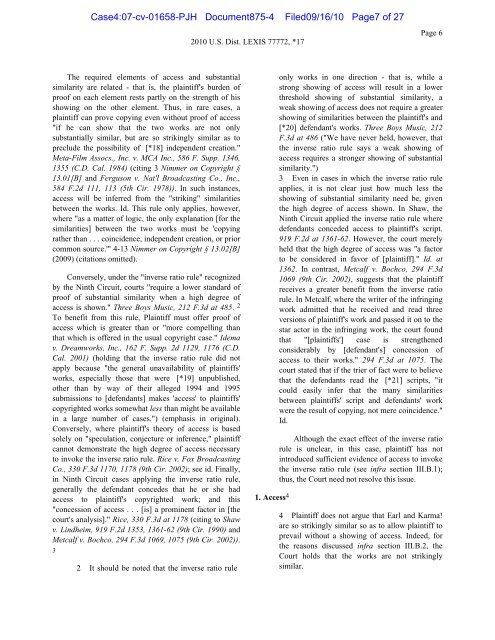exhibit 2 - SAP Lawsuit Portal
exhibit 2 - SAP Lawsuit Portal
exhibit 2 - SAP Lawsuit Portal
You also want an ePaper? Increase the reach of your titles
YUMPU automatically turns print PDFs into web optimized ePapers that Google loves.
The required elements of access and substantial<br />
similarity are related - that is, the plaintiff's burden of<br />
proof on each element rests partly on the strength of his<br />
showing on the other element. Thus, in rare cases, a<br />
plaintiff can prove copying even without proof of access<br />
"if he can show that the two works are not only<br />
substantially similar, but are so strikingly similar as to<br />
preclude the possibility of [*18] independent creation."<br />
Meta-Film Assocs., Inc. v. MCA Inc., 586 F. Supp. 1346,<br />
1355 (C.D. Cal. 1984) (citing 3 Nimmer on Copyright §<br />
13.01[B] and Ferguson v. Nat'l Broadcasting Co., Inc.,<br />
584 F.2d 111, 113 (5th Cir. 1978)). In such instances,<br />
access will be inferred from the "striking" similarities<br />
between the works. Id. This rule only applies, however,<br />
where "as a matter of logic, the only explanation [for the<br />
similarities] between the two works must be 'copying<br />
rather than . . . coincidence, independent creation, or prior<br />
common source.'" 4-13 Nimmer on Copyright § 13.02[B]<br />
(2009) (citations omitted).<br />
Conversely, under the "inverse ratio rule" recognized<br />
by the Ninth Circuit, courts "require a lower standard of<br />
proof of substantial similarity when a high degree of<br />
access is shown." Three Boys Music, 212 F.3d at 485. 2<br />
To benefit from this rule, Plaintiff must offer proof of<br />
access which is greater than or "more compelling than<br />
that which is offered in the usual copyright case." Idema<br />
v. Dreamworks, Inc., 162 F. Supp. 2d 1129, 1176 (C.D.<br />
Cal. 2001) (holding that the inverse ratio rule did not<br />
apply because "the general unavailability of plaintiffs'<br />
works, especially those that were [*19] unpublished,<br />
other than by way of their alleged 1994 and 1995<br />
submissions to [defendants] makes 'access' to plaintiffs'<br />
copyrighted works somewhat less than might be available<br />
in a large number of cases.") (emphasis in original).<br />
Conversely, where plaintiff's theory of access is based<br />
solely on "speculation, conjecture or inference," plaintiff<br />
cannot demonstrate the high degree of access necessary<br />
to invoke the inverse ratio rule. Rice v. Fox Broadcasting<br />
Co., 330 F.3d 1170, 1178 (9th Cir. 2002); see id. Finally,<br />
in Ninth Circuit cases applying the inverse ratio rule,<br />
generally the defendant concedes that he or she had<br />
access to plaintiff's copyrighted work; and this<br />
"concession of access . . . [is] a prominent factor in [the<br />
court's analysis]." Rice, 330 F.3d at 1178 (citing to Shaw<br />
v. Lindheim, 919 F.2d 1353, 1361-62 (9th Cir. 1990) and<br />
Metcalf v. Bochco, 294 F.3d 1069, 1075 (9th Cir. 2002)).<br />
3<br />
Case4:07-cv-01658-PJH Document875-4 Filed09/16/10 Page7 of 27<br />
2 It should be noted that the inverse ratio rule<br />
2010 U.S. Dist. LEXIS 77772, *17<br />
1. Access 4<br />
Page 6<br />
only works in one direction - that is, while a<br />
strong showing of access will result in a lower<br />
threshold showing of substantial similarity, a<br />
weak showing of access does not require a greater<br />
showing of similarities between the plaintiff's and<br />
[*20] defendant's works. Three Boys Music, 212<br />
F.3d at 486 ("We have never held, however, that<br />
the inverse ratio rule says a weak showing of<br />
access requires a stronger showing of substantial<br />
similarity.")<br />
3 Even in cases in which the inverse ratio rule<br />
applies, it is not clear just how much less the<br />
showing of substantial similarity need be, given<br />
the high degree of access shown. In Shaw, the<br />
Ninth Circuit applied the inverse ratio rule where<br />
defendants conceded access to plaintiff's script.<br />
919 F.2d at 1361-62. However, the court merely<br />
held that the high degree of access was "a factor<br />
to be considered in favor of [plaintiff]." Id. at<br />
1362. In contrast, Metcalf v. Bochco, 294 F.3d<br />
1069 (9th Cir. 2002), suggests that the plaintiff<br />
receives a greater benefit from the inverse ratio<br />
rule. In Metcalf, where the writer of the infringing<br />
work admitted that he received and read three<br />
versions of plaintiff's work and passed it on to the<br />
star actor in the infringing work, the court found<br />
that "[plaintiffs'] case is strengthened<br />
considerably by [defendant's] concession of<br />
access to their works." 294 F.3d at 1075. The<br />
court stated that if the trier of fact were to believe<br />
that the defendants read the [*21] scripts, "it<br />
could easily infer that the many similarities<br />
between plaintiffs' script and defendants' work<br />
were the result of copying, not mere coincidence."<br />
Id.<br />
Although the exact effect of the inverse ratio<br />
rule is unclear, in this case, plaintiff has not<br />
introduced sufficient evidence of access to invoke<br />
the inverse ratio rule (see infra section III.B.1);<br />
thus, the Court need not resolve this issue.<br />
4 Plaintiff does not argue that Earl and Karma!<br />
are so strikingly similar so as to allow plaintiff to<br />
prevail without a showing of access. Indeed, for<br />
the reasons discussed infra section III.B.2, the<br />
Court holds that the works are not strikingly<br />
similar.


